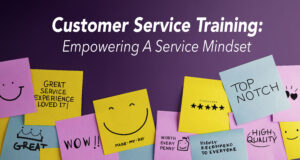Creating a Winning Customer Service Culture is Within Your Grasp

Customer service used to be viewed as the final link in the overall chain of customer touch points, a responsibility relegated to a department, contact center or automated attendant that would respond to complaints and (hopefully) eventually make things right.
Most companies now recognize that customer service is much bigger than a single function that operates primarily in a reactive manner. In fact, in many cases, superior customer service is now one of the most powerful secret weapons an organization has.
In one recent study, among many with similar findings, 78% of respondents said good customer service is fundamental to earning their loyalty and business. And retaining those customers is serious business: Just a 5% increase in customer retention can produce more than a 25% increase in profits.
Clearly, a customer service culture pays dividends, and that’s just one of the reasons you see so many companies touting their “customer obsession” through values like empathy, friendliness, accountability, honesty and transparency. Leaders know that customer expectations are higher than ever.
With the advent of more sophisticated customer service technology, many organizations are now frantically researching and adopting new solutions that they hope will reimagine the contact center. But automation, AI, AR, video and others are only tools. They’re not the centerpiece from which a culture can emanate — and, increasingly, they won’t be a differentiator for your brand. Like everything else related to business culture, your unique customer service culture hinges on your people.
It Takes More Than Words to Build a Customer Service Culture
As a customer yourself, you’ve probably seen or heard it a million times: “We value you as a customer.” “Your business is important to us.” “Customers come first.”
There’s nothing wrong with these statements — as long as you remember that they’re just words. To truly create a customer service culture, those words and values have to show up in the everyday attitudes, behaviors and actions of each of your employees.
And here’s the kicker: That human connection is pivotal, even when everything goes right with the technology.
For example, let’s say you’ve finally found the perfect app. It’s become one of your most valuable business tools. So when you get a notification that there’s an update available, you immediately download it…only to discover that in the process of updating the app, the company has completely messed up one of its best features.
As a long-time, loyal customer, you decide to submit a ticket to get the issue fixed. (You would have called, but there’s no phone number to be found anywhere). A couple of weeks go by. No response. No visible action. And then one day, you get an email: The problem has been solved, and we’ve closed your ticket.
There’s no reference to the issue—in fact, no way to tell that they’re even referring to your specific issue. But assuming that they are, there’s no information about when the new update will be released, how it will solve the problem or what you should do in the meantime. There’s no indication that someone has looked at your account or even cares whether your needs have been addressed. All you know is that the ticket’s been closed, and only time will tell if the problem was truly resolved.
Well, there’s one other thing you know: As soon as a competitor comes out with another option, you’re going to be first in line to check them out.
Remember that stat about the value of customer retention? While the technology may have solved the problem at hand, it inadvertently created a much bigger customer service and business issue in the process.
Of course, these kinds of problems happen just as frequently when there’s an identifiable human on the other end of the line. That doesn’t necessarily mean some people have bad intentions or don’t care about the customers. In many cases, it simply means they haven’t been given a clear process and framework to turn those words into action on a day-to-day and moment-to-moment basis.
The point is, whether or not technology is part of the equation, it’s paramount that companies pay attention to the human factor. Service breakdowns happen. That’s just reality. But even when an issue can’t be resolved, the best reps leave their customers feeling heard, appreciated and more loyal to the company as a result.
Customer Service Training and the Value of Process
The big problem is that too many companies are failing the customer, the rep and the business by not equipping their people to effectively meet customer needs.
But investing in customer service training isn’t a guarantee that you’ll have the desired impact on day-to-day behavior and the work environment. It takes more than product knowledge and a script to help someone be customer-focused. Training, values and the overall culture need to be aligned and interconnected. A common language and process for how we treat people (whether internal or external customers) is the glue that brings them together.
For customer service training to make a lasting impact both inside and outside the organization, it needs to be grounded in process.
Here’s how an effective customer service process will serve the needs of your learners, your culture and your customers.
Allow people to bring out their best, day in and day out
The best problem-solving process both enhances what people already do best and enables them to do it more consistently and effectively, because they have that anchor to go back to when they start to veer off course. By helping people align their attitudes and beliefs with the cultural expectations, it also provides a clear path to follow, one that makes the values tangible and actionable.
Changes mindsets about problem-solving
A script or product FAQ only skims the surface of a problem. To fully solve the problem and build stronger customer loyalty, you have to go deeper. An effective problem-solving process helps people engage with the customer so they can discover not just the problem but also the true cause of the problem—as well as all the viable options for solving it. And it reminds them to follow up to make sure the solution really worked.
Establishes a neutral baseline for accountability
When you have a common framework and approach for how customer service values translate into daily behaviors, you can hire, coach, evaluate and train to it. It’s impossible to coach to everyone’s personality. A process gives you an objective standard and reference point.
Makes the customer service culture a requirement rather than a job requirement
At one of the largest international energy companies, their customer service culture is about creating “customers for life.” Customer service training isn’t relegated to a specific job title or department. Customer service is central to their company growth strategy. The company launches with as many divisions and roles as possible—together—to build stronger collaboration across departments to increase communication, productivity, and overall customer focus. They know that without buy-in and role-modeling from the top, the culture across all employees won’t stick. Having a consistent process makes it that much easier for everyone to get on board and on the same page.
Creates opportunities to strengthen customer loyalty
While poor customer service can drive customers away, a good process can turn them into your biggest fans. After all, when you’ve solved a customer’s problem effectively and demonstrated through your behaviors and follow-up that you really care, there’s a good chance that customer will be more loyal than one who never had a problem to begin with.
We’re all individuals. We all have different motivations and personalities. And of course, we’re all human—we each have good days and bad days. A process is what keeps you anchored, consistent and aligned with the values the organization advertises to the world. Talking about a customer service culture is important, but a process is what helps create and fuel that culture.
A Customer Service Culture That Permeates Every Touchpoint
A reactive, end-of-lifecycle approach to customer service is old school thinking. To get the biggest impact, a customer service mindset has to be instilled across the organization. That’s what culture’s all about. And that’s why you can’t limit what you do to just your call center and service teams.
Your leaders and managers play a critical role in making sure you have alignment and accountability for excellent customer service at every customer touchpoint. Effective coaching is what closes the loop. It reinforces the why, the purpose and the values that connect teams to each other and to the mission. It reminds people of how the work they do every day is making a difference for the customer. That’s a powerful motivator. It greases the wheels of collaboration. It creates more energy and engagement. And it makes it easier for everyone to keep the customer at the center of everything they do.
So remember: The technology and the values statements are helpful. But they don’t replace the essential role your people play. Equip your teams to truly deliver on the promise of a strong customer service culture, and your customers will thank you.

Vice President of Client Development
Related Blog Posts



